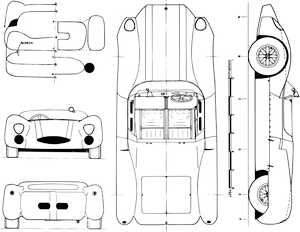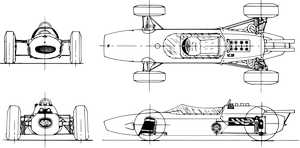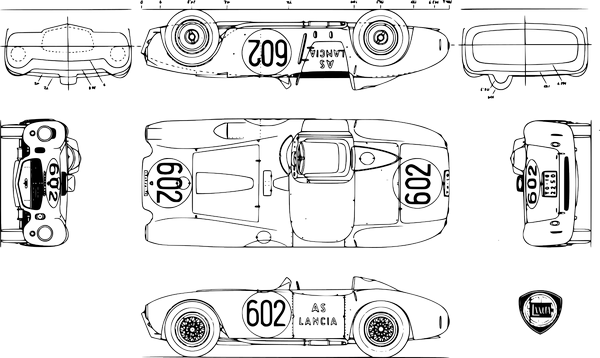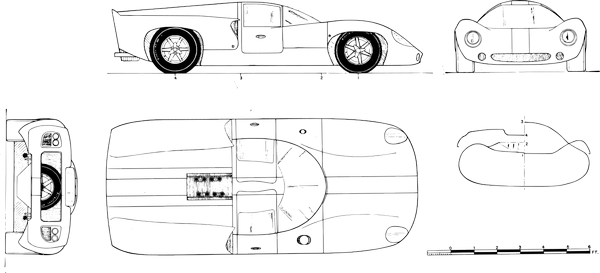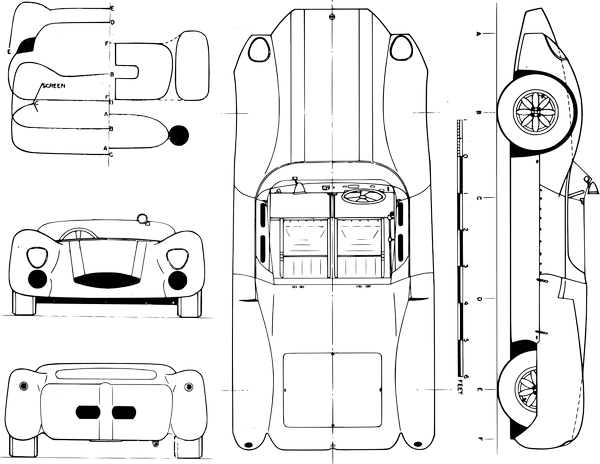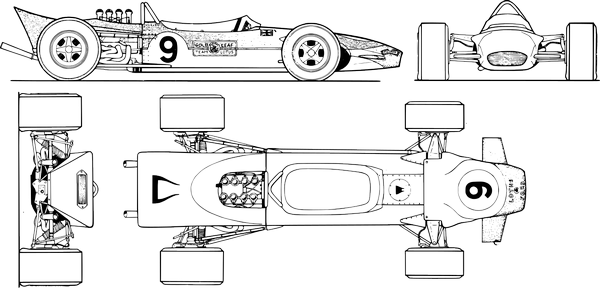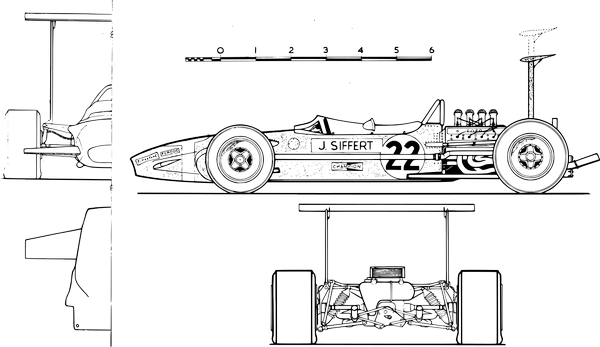Scale Plan Series #6 | Model Car & Track October 1964 | By Jonathan Thompson
Lancia D24
H AVING Vittorio Jano, designer of the famous P2 and B2900 Alfas in their employ since 1938, Lancia & C. of Turin could hardly be expected to continue their non racing policy indefinitely, especially when the young and enthusiastic Gianni Lancia took control of the firm in 1953.
Jano had designed the well known Aurelia V6 engine for Lancia; this unit, increased in displacement from 1754cc to 1991cc, appeared in the very sporting and desirable B20 Gran Tourismo coupe.
In 1951 Giovanni Bracco had won the 2-liter class and placed 2nd overall in the Mille Miglia, defeating all the Ferraris except that of Luigi Villoresi. At Le Mans the Bracco/Giovanni Lurani Lancia again took the 2-liter class, placing 12th in the general classification.
The following year the modified Serie II Aurelias made their debut in the Giro di Sicilia (Tour of Sicily). The engines had four carburetors, a modified valve operation. and produced 106 b.h.p. at 5500 r.p.m. Innovations were the floor shift, enlarged brakes, lower body, and overall weight saving of 220 lb. The race was won by Paolo Marzotto's 2-liter Ferrari, but the Lancias took the next three places in the order Felice Bonetto, Gino Valenzano, and Salvatore Ammendola. The Gran Turismo Lancias again overwhelmed the 2-liter class in the Mille Miglia, taking the 3rd, 5th, 6th, and 8th places overall (Luigi Fagioli. Enrico Anselmi. “Ippocampo," and Ammendola) and being beaten only by Bracco's Ferrari and Karl Kling's Mercedes-Benz 300SL. Rudolf Caracciola was 4th in another Mercedes.
At Le Mans the Valenzano/"Ippocampo" Lancia took 6th overall and, of course, the 2-liter class. In the Carrera Pan-americana Mexico the Aurelias of Bonetto and Giulio Cabianca retired on the first stage, but Umberto Maglioli turned in a beautiful and consistent performance to finish 4th behind the Mercedes of Kling and Hermann Lang and the Ferrari of Luigi Chinetti. The Lancia successes were owed more to the superb suspension and steering, plus the light weight, than to the power output, which was considerably below that of the competition.

With such an excellent background, the appearance of an entirely redesigned sports car in 1953 stirred up considerable excitement. The new model, which made its racing debut in the Mille Miglia on April 26, was still a coupe and retained a V6 engine and rear mounted clutch gearbox differential unit, but there the resemblance ended. The engine had a displacement of 2962cc, twin overhead camshafts, inclined valves, two plugs per cylinder, and three double bodied Weber carburetors; output was 210 b.h.p. at 6700 r.p.m. A triangulated frame of small tubing was employed, while mammoth brakes were mounted inboard, directly to the frame in front and to the differential in the rear. This gave a considerable saving in unsprung weight. Front and rear suspension consisted of trailing arms, transverse leaf springs, and telescopic shock absorbers. Thus the traditional Lancia sliding pillar and coil spring front suspension was abandoned.
The body was a lower, sleeker, and very handsome creation by Pinin Farrina, painted blue with an off-white roof. The radiator grille was not used, but the opening retained the classic Lancia shape. The older Aurelia continued to race as a Gran Turismo car with its displacement increased to 2451cc.
Four 3-liter cars were entered in the Brescia Rome Brescia event for Maglioli Bonetto, the Mille Miglia ace Clemente Biondetti, and Piero Taruffi. Competition was fierce in the form of several 4.1 liter Ferraris and a team of 3.5-liter Alfa Romeos. Taruffi ran second to Consalvo Sanesi's Alfa on the first stage (Brescia-Verona), but retired shortly afterward with problems in the new front brakes. Bonetto and Maglioli began to move up among the leaders, being 5th and 6th at Rome and 4th and 5th at Florence. Maglioli dropped out before Bologna, but Rosetta moved up to 3rd at the finish. Biondetti was 12th at Rome, 9th at Florence, 8th at Bologna, and undoubtedly would have finished among the first six had his car not broken down 2½ miles from Brescia. With the help of his mechanic, Biondetti pushed the car to the line, receiving 8th place for his efforts. The race was won by Giannino Marzotto's Ferrari 4.1 at 88.39 m.p.h.; Bonetto was 30 min. back and 18 min. behind Juan Manuel Fangio's Alfa Romeo, which was driven over the last two stages with only one wheel steerable after the suspension collapsed!
The Targa Florio was held over the tortuous 44 mile Sicilian circuit on May 14. Although four cars were entered for Bracco, Bonetto, Taruffi, and Maglioli, Bonetto's was involved in a needless pre-race crash and did not start. In this race, where sheer power is often an embarrassment, the chief opposition came from the Maserati team of Fangio, Emilio Giletti, and Sergio Montovani in 2-liter cars. Bracco went fast initially, but Giletti was ahead on the 2nd lap. Bracco took the lead but went off the road in the rain and retired. On the 7th lap Taruffi passed his teammate Maglioli into the lead and set a lap record of 54.07 m.p.h., but crashed near the spot that had seen Brasco's misfortune. Maglioli thus regained the first position, and the open road specialist was rewarded for his fast and steady drive with victory at 50.07 m.p.h.
For Le Mans, June 13-14, Lancia put their faith in a moderate boost Roots supercharger, reducing the displacement to 2683cc to gain an advantage on handicap. Four cars appeared for Taruffi/ Maglioli, Robert Manion/Louis Chiron, Bonetto/Volenzano, and Froilan Gonzalez/Biondetti; all retired, the Gonzalez/ Biondetti car lasting the longest (18 hours). The lack of speed was shown by the fact that no Lancia ever got higher than 11 th place. The fastest laps of the four cars ranged from 4 min 46.7 sec. to 4 min. 59.1 sec., compared with 4 min. 29.7 sec. for the winning Jaguar XK-120C of Tony Rolt and Duncan Hamilton, who averaged 105.78 m.p.h. The fastest Lancia (Taruffi/Maglioli) achieved 136.48 m.p.h. over the timed kilometer; the Phil Walters/John Fitch Cunningham CSR did 154.81 m.p.h.
The Gran Premio Monza, a two-heat event limited to sports cars of 3-liters, was held two weeks later. Three Lancias, reverting to the unsupercharged 2962cc engines, were entered for Gonzalez, Bonetto, and Manzon. The first two were brand new Farina roadsters, or spyders, with a 6.3-in. reduction in wheelbase and a new rear suspension retaining the transverse leaf spring but incorporating a De Dion tube, located by a sliding guide and parallel radius rods, behind the differential.
In the first heat Alberto Ascari and Villoresi led with their Ferraris before the former was involved in a collision. Gonzales and Bonetto were right behind Villoresi until the 21st lap. when Gonzalez retired. Bonetto finished 2nd, while Manzon's coupe was not running well and ended up 13th. It retired on the 1st lap of the second heat, while Bonetto was again 2nd to Villoresi, who averaged 109.01 m.p.h. for the combined heats.
The Coppa d'Oro delle Dolomiti (Dolomite Gold Cup), held on July 12, was won by Paolo Marzotto's 3-liter Ferrari at 57.08 m.p.h. Taruffi was 2nd, 1 min. 33.4 sec. behind, in his 3-liter Lancia spyder, while Bonetto was 9th. Bonetto was consoled by a win and fastest lap in the Grande Premio do Jubileu (Jubilee Grand Prix, run at Lisbon on July 26). After Taruffi's retirement Bonetto had no difficulty building a one lap lead over Stirling Moss' Jaguar C, winning at 82.68 m.p.h.
Scuderia Lancia tested the new 3.3 liter (3287cc) D24 spyder at the Nurburgring, speeds being impressive. Fangio was now a member of the team, which seemed unbeatable in the upcoming Internationales ADAC 1000 Kilometer Rennen on August 30. In practice the Argentine driver lapped at 83.1 m.p.h., approaching the Formula 2 record. Nevertheless, the Ascari/Giuseppe Farina 4.5 Ferrari was the winner of the race at 74.7 m.p.h., after the Fangio/Bonetto 3.3 was eliminated by fuel pump trouble and the.Manzon/Taruffi 3.3 and the Bracco/ Eugenio Castellotti 3.0 retired with battery failure which prevented their restarting after a pit stop. Until this happened the Lancias had dominated the race. Manion set the fastest lap at 80.0 m.p.h.
The 3.3-liter cars could be distinguished from the original 3.0 spyder by the slightly longer and lower nose, the large scoop on the right fender, the replacement of the long carburetor scoop by a shorter one on the hood only, and by a generous amount of extra slots and louvers. A new gearbox was used with the four speeds below the differential instead of in line with it; a new rear suspension placed the De Dion tube in front of the final drive and used two quarter elliptic springs.
Returning to Italy for the first Gran Premio Supercortemaggiore (Merano, September 6), the team comprised Bonetto and Taruffi in 3.3-liter cars and Bracco and Castellotti in 3.0 machines. Fangio was temporarily back on the Alfa Romeo team in a 3.5-liter spyder; he won the race at 78.97 m.p.h. after Bonetto dropped out while leading. The other three Lancias also retired, making two races in a row without a finisher. In spite of having the best machinery by far, Scuderia Lancia was suffering from a lack of reliability.
Preparations for the Carrera Panamericana (November 19-23) were thus extremely thorough. The displacement was dropped to 3.1 liters on the Fangio, Bonetto, and Taruffi cars, while Castellotti's and Bracco's were the original 3.0 type. The team arrived in Mexico with an impressively large and modern transporter, plenty of spares, and a well trained crew of mechanics.
The results were in keeping with the effort. On the first leg the order was Bonetto, Taruffi, Fangio, and Castellotti, with Bracco 7th. Bonetto and Taruffi duelled on the next two stages with Bonetto holding the overall advantage, but on the Mexico City Leon leg Bonetto crashed into a lamp post and was killed instantly.
Taruffi stopped immediately with the intention of rendering aid, this loyal action dropping him from a certain 1st place to 10th on that stage, and 4th overall. Bracco retired on the same stage after losing a wheel; he had been running 6th. Taruffi won the next leg and moved up to 2nd overall, while on the last three stages Maglioli's Ferrari 4.5 (taken over from Ricci) was fastest, but not fast enough to move up among the Lancias on overall time. Fangio was the winner through consistency, not having won any of the eight stages, he nevertheless maintained a high average and led his teammates Taruffi and Castellotti to a well deserved 1-2-3 sweep for Lancia, the winning average being 105.73 m.p.h. Although he did not make as great a mark in Grand Prix racing, Felice Bonetto was one of the world's best sports car drivers; his death was a great loss to the team.
Lancia tied with Cunningham for 4th place in the 1953 World Championship for Sports Cars, with 12 points. Ferrari. Jaguar, and Aston Martin scored 30, 27, and 16 points respectively. Lancia had entered four of the seven events, but the complete retirements at Le Mans and the Nurburgring spoiled their chances. After the triumph in Mexico, Scuderia Lancia arrived in Florida the favorites for the Sebring 12-hour endurance race on March 7, 1954. Ascari and Villoresi had signed with Lancia for the season (mainly to drive the eagerly awaited D50 Grand Prix cars), completing what was probably the greatest group of drivers ever assembled in one team: Fangio/ Castellotti, Ascari/Villoresi, and Taruffi/ Manzon in 3.3-liter cars, with the 3-liter car of Valenzano/Porfirio Rubirosa an added precaution. As it turned out, this last car finished 2nd behind Moss' OSCA after the other Lancias dropped out; Taruffi was once again robbed of victory after leading at ten of the first eleven hour intervals (the Ascari/Villoresi car led at the 2nd hour). When the engine of Taruffi's car seized an hour before the finish, he pushed the Lancia a mile and a half to the pits, but the mechanics could not get it going again. Rubirosa had not been running among the first 25 cars during the early hours, but the veteran Valenzano was able to bring the car up to 2nd at the end to salvage some honor for Turin. Moss averaged 72.8 m.p.h.
After this unexpected defeat Scuderia Lancia returned to Europe where the D24s won their next four races in no uncertain manner. Taruffi took one 3.3 liter car to Sicily for the Giro di Sicilia (April 4), which he won at 64.24 m.p.h. after fighting with Maglioli's 4.9 Ferrari in the opening stages.
When Villoresi was injured in a minor event at San Remo, Ascari, who had not wished to run in the Mille Miglia (May 2), took his place in the 1000 mile race, Taruffi and Castellotti piloting two additional 3.3 liter cars.
Taruffi led all the way to Rome, but dropped out shortly afterward according to the pre Moss tradition of the Italian classic. Almost in spite of himself, Ascari has scored a valuable victory for Lancia at 86.72 mph. Lancias had been 1-2-3 on the first two legs, but Castellotti retired after the Pescara control. Taruffi made up for his retirement in the Mille Miglia by winning another event in Sicily, the Targo Florio on May 30. Just as in the previous year, the 2 liter Maseratis were the strongest opponents of Scuderia Lancia. Although the 3.3 liter D24 was overpowered for the rugged test, Taruffi drove carefully and defeated the up and coming Luigi Musso (Maserati), who was suffering the results of unwise eating the night before the race and did well to place 2nd. Castellotti, in a second Lancia 3.3, set the fastest lap of the race at 57.82 mph., but went off the road, damaged the suspension, and eventually retired. Taruffi averaged 55.85 mph.
Recovering from his San Remo accident, Luigi Villoresi celebrated by winning the Grand Premio do Porto (Portugal, June 27) at 92.52 mph. Castelloti finished 2nd in a similar 3.3 liter Lancia, while Ascari, driving an enlarged 3.6 liter model, retired with transmission seizure after leading for 39 of the 45 laps.
The last international event in which the D24 sports Lancias ran was the Tourist Trophy, held at Dundrod, Northern Ireland, on September 11. An impressive team was fielded, with Ascari/ Villoresi and Fangio/Castellotti in further enlarged 3.8 liter (3750cc) cars, and Taruffi/Roberto Piodi and Manzon/ Valenzano in 3.3 liter machines. On the 3.8 liter cars the inboard brakes were abandoned front and rear, while the trailing arm front suspension gave way to a more conventional parallel wishbone layout.
The race, run on handicap, was won by the little DB of P. Armagnac/G. Loureau, although on actual laps covered the fastest car was the Mike Hawthorn/ Maurice Trintignant 3.0 Ferrari. which averaged 86.08 mph. Second was the Lancia of Tarruffi and Fangio (the latter's car having retired) and third that of Manzon and Castellotti, who replaced Valenzano. The 3.8 of Fangio/Castellotti retired with engine failure while the Ascari/Villoresi car broke a universal joint on the driveshaft. The 3.8 Lancia reached 144 mph on the flying kilometer, compared with 140 mph for the Ferrari, but Hawthorne set the fastest lap at 92.38 mph.
Competing in only four of the six qualifying events, Scuderia Lancia scored 25 points in the 1954 World Championship for Sports Cars, finishing but 3 points behind the title winning Ferrari. Lancia was actually 3 points ahead of Ferrari going into the final race, the Carrera Panamericana, but did not enter (being more concerned with the development of the Grand Prix car) and forfeited the championship when Magioli's 4.9 Ferrari won in Mexico. It would be safe to say that during 1953-54 the 3.0, 3.3, and 3.8 liter Lancias were consistently the fastest machines in sports car racing. Had the team gone to Mexico in 1954 it might well have taken the official honors from Ferrari. As it was, Taruffi at least became the 1954 Italian Sports Car Champion, having won the Giro di Sicilia and the Targa Florio.
The sports Lancias also won a number of hill climbs and point to point sprint races; the following were all won by Eugenio Castellotti, except as noted:
1953 — Coppa della Consuma (Biondetti, 3.0), Catania-Etna (3.0), Bologna-Rati-tuna (Bonetto, 3.0), Pontedecimo-Giovi (3.0); 1954 — Bolzano-Mendola (3.3), Aosta-Gran San Bernardo (3.3), Bologna-Raticosa (3.8), Catania-Etna (Ta-ruffi, 3.3), Treponti-Castelnuovo (3.3), and Firenze (Florence)-Siena (3.3). Naturally Castellotti won the 1954 Trofeo della Montages (Mountain Trophy).
Lancia continued in Grand Prix racing until the death of Alberto Ascari in the spring of 1955; toward the end of the year all the racing machinery, equipment and drawings were turned over to Ferrari, who fielded the successful Lancia Ferrari D50 cars in 1956 and the rather unsuccessful modified version in 1957. Lancia has recently taken a renewed interest in competition with the Flavia Sport Zagato prototype GT cars of 1800 and 2000cc. Perhaps the Turin firm is on its way again.
SPECIFICATIONS: Engine, 60-degree V6; twin overhead camshafts each bank, inclined valves, two spark plugs per cylinder; 86 x 85mm, 2962cc; 210 bhp (est.) at 6700 rpm, 70.8 bhp/liter. Le Mans engine, 2683cc with belt-driven, moderate-boost Roots supercharger between the cylinder banks. D24 engine, 3287cc; 240 bhp (est.) at 7000 rpm, 73.0 bhp/liter; later 3750cc, 265 bhp (est.) at 7000 rpm, 70.6 bhp/liter. Clutch, four speed gearbox, and differential in unit at the rear. Triangulated space frame of small diameter tubing; stressed-skin aluminum body by Pinin Farina. Front suspension, independent by trailing arms, transverse leaf spring, and telescopic shock absorbers, with inboard drum brakes; later replaced by parallel wishbone suspension and hub mounted brakes. Rear suspension, independent by trailing arms, transverse leaf spring, and telescopic shock absorbers; subsequently replaced by modified layout with De Dion tube behind final drive, still later by De Dion tube in front of final drive and two quarter-elliptic springs (brakes moved outboard to hubs on final 3.8-liter cars). Knock-off Borrani wire wheels. Tires, Michelin X 165 x 400 (Mille Miglia and Targa Florio 1953), and Pirelli Corsa 6.00 x 15 front, 6.50 or 7.00 x 15 rear. Dry weight, 1870 lb.
DIMENSIONS (est.): Coupe — Wheel-base 98.4 inches. Track, 50.8 inches front, 51.1 inches rear. Length 153.9 inches. Overhang, 21.7 inches front, 33.8 inches rear. Width 62.0 inches. Height 48.5 inches. 3.3 and 3.8 Spyder — As for coupe, except: Wheelbase 92.1 inches. Length 150.2 inches. Overhang, 24.8 inches front, 33.3 inches rear. Height 39.0 inches (headrest).
COLORS: Coupe bodywork medium blue with off-white roof. Hood scoops usually painted different colors to distinguish the drivers. At Monza 1953 spyders were blue with Bonetto's having a red radiator and hood scoop, Gonzalez' a red radiator and fender flashes, and Manzon's coupe a red radiator, hood scoop, and fender flashes. With the introduction of the D24, bodywork became Italian racing red overall. Numbers white, or black on a white disc (specified below as b/w).
NUMBERS: (1953) Mille Miglia — Maglioli 554, Bonetto 606, Biondetti 616, Taruffi 619. Targa Florio — Bracco 24, (Bonetto 30), Maglioli 76, Taruffi 84. Le Mans (b/w) — Taruffi/Maglioli 30, Manson/Chiron 31, Bonetto/Yalenzano 32, Gonzalez/Biondetti 63. Monza — Gonzalez 2, Bonetto 4, Manson 6. Dolomiti — Taruffi 86. Lisbon (b/w) — Bonetto 24, Taruffi 25. Nurburgring — Fangio/Bonetto 5, Manzon,Taruffi 6, Bracco/Castellotti 7. Supercortemaggiore — Castellotti 34, Bracco 36, Bonetto 38 (white checkered nose band), Taruffi 40. Mexico (b/w) —Taruffi 22, Bonetto 34, Fangio 36, Castellotti 38, Bracco 50. (1954) Sebring (b/w) — Fangio/Castellotti 36, Ascari/Villoresi 37, Taruffi/ Manion 38, Yalenzano/Rubirosa 39. Giro di Sicilia (b/w) — Taruffi 355. Mille Miglia (b/w) — Castellotti 541, Taruffi 547, Ascari 602. Targo Florio — Castelotti 70 (white nose band), Taruffi 76. Porto (b/w) —Villoresi 1. Tourist Trophy (b/w) — Ascari/Villoresi 1, Fangio/ Castellotti 2, Taruffil(Piodi)/Fangia 3, Manzon/(Valenzano)/Castellotti 4.
In the Carrera Panamericana, the first two letters of the driver's name (FA, BO, TA, etc.) appeared on the driver's door. On the last two stages, mechanics were carried, necessitating an extra screen and the removal of the fairing over the passenger seat. At Sebring the name LANCIA was lettered on the hood and on both sides. At the Mille Miglia the name LANCIA and the first two letters of the driver's name (AS, TA, CA) appeared on both sides; the same procedure was used at Porto. License plates (prefix TO for Torino) were carried in all races!



